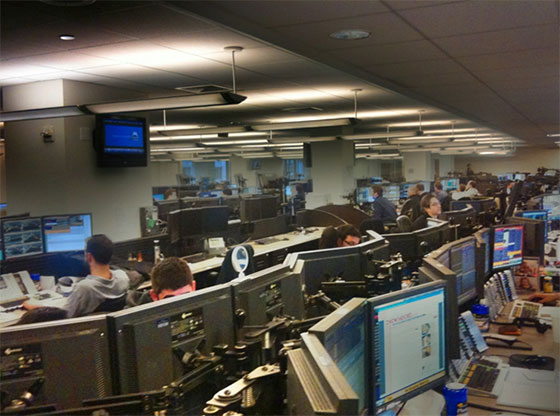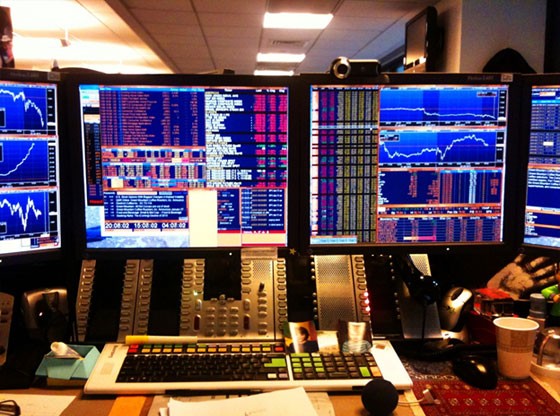When I ran Equity Derivatives for Cantor Fitzgerald, it was a wild time.
Picture a trading floor like in the movies. More than 100 people lined up in rows of desks on one floor. Each person fixated on stock prices on four computer monitors.
They franticly barked buy and sell orders down one or both of the two phone handsets in front of them. Each phone had 80 speed dials on it.

NYC Equities Floor

My desk
And floating above all that din was the screech of the “hoot” – essentially, an intercom system shared by the 100 people in the New York dealing room and another 150 equity sales traders from around the country (and more around the world).
It was electric, and I loved it. Those 250 sales traders were each hurriedly talking to their clients – collectively, thousands of hedge funds and big wig investors.
And each person needed to differentiate themselves from their competitors… Of which there were plenty. Why would one portfolio manager listen to their Cantor coverage as opposed to Morgan Stanley, JPMorgan, or anywhere else?
It usually boiled down to information.
On Wall Street, information is key. Whoever had the best actionable intel got the big juicy orders and earned a fat commission in the process.
Remember the movie Wall Street when the character Bud spread info? “Blue Horseshoe loves Anacott Steel.”
While my trading floor wasn’t quite that dramatic, it was awash with daily information. At any given moment, someone needed to know information on a stock.
The problem was, while information was always at the ready, much of the time, no one had any real good reason as to what was moving a stock. People often had no clue.
I’m Jason Bodner, the editor of Outlier Investor here at Brownstone Research. I worked for nearly two decades on Wall Street, learning the ins and outs of the financial world.
Most people have little idea what really goes on behind the scenes on the Street. It’s a vastly different playing field than regular investors are used to. And that means Main Street often operates at a disadvantage.
That’s a big reason why I left Wall Street to head out on my own. I knew I could give regular people an insider’s view of how hedge funds and other big institutional investors operate. And in doing so, I could help my readers make a lot of money.
And today, I’m bringing readers another “peek behind the curtain” at Wall Street’s inner workings…
During my time at Cantor, I’d often hear tips and insight being exchanged.
Bill would come over the hoot from San Francisco and ask, “Anyone hearing anything about Pep Boys?”
Someone would answer, “Weedon, the broker, just put out positive comments on it.”
Jake from New York might say over the hoot: “Anyone know why Ford is down?”
It wouldn’t take long for someone from Dallas to respond: “I’m hearing there’s a supply chain disruption for dash components.”
There was always an answer.
But here’s the problem: The answers were often totally irrelevant, wrong, or just flat-out fabricated.
I found out by witnessing it myself.
One day, I was trading 90,000 options on a popular chipmaker stock. That’s nine million shares of a $23 stock at the time. That single trade was worth more than $200 million. All in a day’s work!
And on top of those options, my client needed to also buy the chipmaker’s stock – a truckload of it. But he was clear with his instructions: I was not to shop his buy order around looking for a natural seller. He wanted to have his order “in the machines” or put into the electronic order system.
Once his buy order was in for the shares, the stock started to take off. Why? He needed to buy a lot of shares, and his buying pressure was lifting the stock price simply because he had to buy more than was available to sell.
I was busy arranging the big options order and simultaneously managing the mongo stock order. I didn’t have time to go over to the hoot and alert the rest of the traders about what was happening.
So when the stock started ripping higher, it wasn’t long before I heard a trader named Biff come over the hoot and ask if anyone knew why the stock was on the move.
Those days, we listened to 20 things at the same time. I was on two phones and typing when I heard his question. I wanted to hop on and answer, but I couldn’t.
A few seconds later, though, someone shared: “I’m hearing a chip shortage is squeezing the stock higher.”
Someone else chimed in: “Also heard them mentioned in a bullish report on chips out of Baird.”
Biff said, “Copy – thanks.”
All that happened before I had time to say what was actually happening: I was buying boatloads of stock for a $3 billion hedge fund. There was no other reason it was going up.
I had a ton to buy, and the buyer wanted it done quietly and in a certain way. I imagine it was partly because lifting the stock immediately improved the paper profit on the call options trade he had just done.
But gossip was now flying at other brokerage houses. Once Biff told his client the “reasons” the stock was going up, that client told competitors. And once other traders on my floor shared the info with their clients who had a stake in the stock… The stories started to spread like wildfire.
The fact is, this kind of “gossip” is how Wall Street really works.
Imagine if Biff had gone back to his client and said this: “The stock is going up because someone is buying it.”
The client would feel frustrated… and Biff would get ridiculed. “That’s no reason!”
It’s likely the client would go with a competitor’s “real” intel… and Biff would miss out on his commission.
On Wall Street, the plain and simple truth doesn’t sell. Clients want juicy gossip. Hedge fund traders need to give their portfolio managers a clear reason why a stock is rising fast, especially if they had a short position.
On Wall Street, you can’t just say, “It’s going up because there’s a big buyer buying.”
It would never fly.
But the simple truth is, there are whale-sized funds that need to buy and sell stock every day.
And in this instance, no positive comment was making the stock rise.
There was no effect from a chip shortage.
There was no basis for the rumors.
The real reason was a massive buyer was outmuscling the market.
While it may help our psyche – and make “clicky” news headlines – there doesn’t need to be a great story behind a stock move. There doesn’t need to be a rumored report or a thematic reason.
There only needs to be a big buyer scooping up a quality stock.
That’s a secret about Wall Street that no one will tell you.
And in the years following my time at Cantor Fitzgerald, I’ve put this idea at the heart of my work. I’ve used it to craft an elite system for tracking this kind of buying action. And when a big buyer takes interest in the highest-quality stocks, I notice.
That’s how my readers have reached gains like 57%, 158%, 399%, and 820% in our model portfolio.
If you’d like to learn more about how to profit along with us, then I’d encourage you to go right here for the full story.
And I’ll keep Wall Street’s secrets coming in future essays, so be sure to stay tuned to keep hearing what really moves markets.
Talk soon,
Jason Bodner
Editor, Outlier Investor
Like what you’re reading? Send your thoughts to feedback@brownstoneresearch.com.
The Bleeding Edge is the only free newsletter that delivers daily insights and information from the high-tech world as well as topics and trends relevant to investments.
The Bleeding Edge is the only free newsletter that delivers daily insights and information from the high-tech world as well as topics and trends relevant to investments.